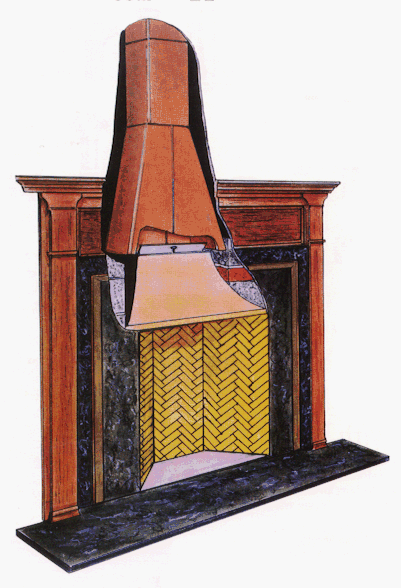Rumford Fireplace Design
3/4/17
|
Use the links below as a guide. Each link will take you to ever increasing detail. If you know pretty much what you're doing you might only use the "specifications" as a guide, check the "code" and print out one of the "plans" as a detail. If you have a complicated job or it's your first time you might find the "instructions" or the "technical discussion" or the "construction process" pictures handy, or email Jim Buckley.
|

|

|
As the arrows indicate, the sloping fireback of the modern fireplace on the right kicks the smoke forward where it mixes turbulently with the dilution air flowing into the face of the fireplace. Masons will tell you that you must "cross over" (build the top of the opening) 8" or 10" below the damper to create an area where the smoke and dilution air mixes before going through a large "gate valve" damper into the flue. If the fireplace opening is too high, or the damper too low, the fireplace will smoke. The Rumford fireplace works on a different principle. The idea of the plumb fireback and rounded streamlined throat is to let the dilution air flow as a sheet of clean air that keeps the smoke and products of combustion behind it flowing up the fireback. Turbulence is undesirable until the dilution air and smoke enter the smoke chamber flowing smoothly through the narrow nozzle-like throat. So what? you might ask. Well, for starters the Rumford fireplace can be built taller and is more efficient and cleaner-burning. The Rumford fireplace can be built much taller than a standard fireplace because of the efficiency of the airfoil throat and control of the smoke flowing up the fireback behind the sheet of clean air. By not mixing the smoke and dilution air more smoke burns in the firebox where it contributes to useful heat rather than exiting the chimney as particulate emissions. The Rumford design increases the "residency time" - the length of time the smoke is hot and in the fire - by about four times compared with the modern fireplace where the smoke is diluted and quenched about 6" over the fire. For more on the physics with some test data to back up these claims, read the JLC article about Rumfords.
|

Back to Training Program for Masons Index
Buckley Rumford Fireplaces
Copyright 1995 - 2017 Jim Buckley
All rights reserved.